Highlights of the 'State of the Canadian Pacific salmon 2019: Responses to changing climate and habitats' report
The State of the Canadian Pacific Salmon: Responses to Changing Climate and Habitats report presents our first overview of how salmon are responding to climate and habitat change. This report is the result of a 2018 workshop, where our scientists presented and discussed recent observations and research on Pacific salmon populations and their ecosystems. Recent marine heatwaves, changes to marine food webs, warmer freshwater conditions, more extreme rain and drought, and various human activities, are all contributing to current trends in salmon numbers.
Some salmon populations are responding better than others, and differences between these populations can provide clues into what may make them more resilient to future climate change. This work forms the base of further research and monitoring that will be used to improve our management of salmon in a changing climate.
The iconic Pacific salmon
Pacific salmon are iconic to Canadians. They are vitally important to Indigenous communities for food, social and ceremonial purposes, and they contribute to the overall socio-economics of Canada’s West Coast through recreational and commercial fisheries. These fish also play a key role in the marine and freshwater ecosystems they use throughout their lives.

We assess and manage the following 5 Pacific salmon species:
- Sockeye (Oncorhynchus nerka)
- Chinook (O. tshawytscha)
- Coho (O. kisutch)
- Pink (O. gorbuscha)
- Chum (O. keta)
A changing global climate
The planet is warming, and the most recent 5 years have been the warmest on record. The increase in global temperature above pre-industrial levels is irreversible over the coming centuries.
In Canada, the rate of warming over the past century has been double the global average, and is even greater at northern latitudes.
There is still time to moderate the severity of climate change and its impacts, through mitigation and adaptation. The extent that we are able to curb our net CO2 and other greenhouse gas emissions will determine the magnitude of future warming. We must also adapt to current and expected climate conditions and their effects, though research and planning.
Global average temperature anomaly by year
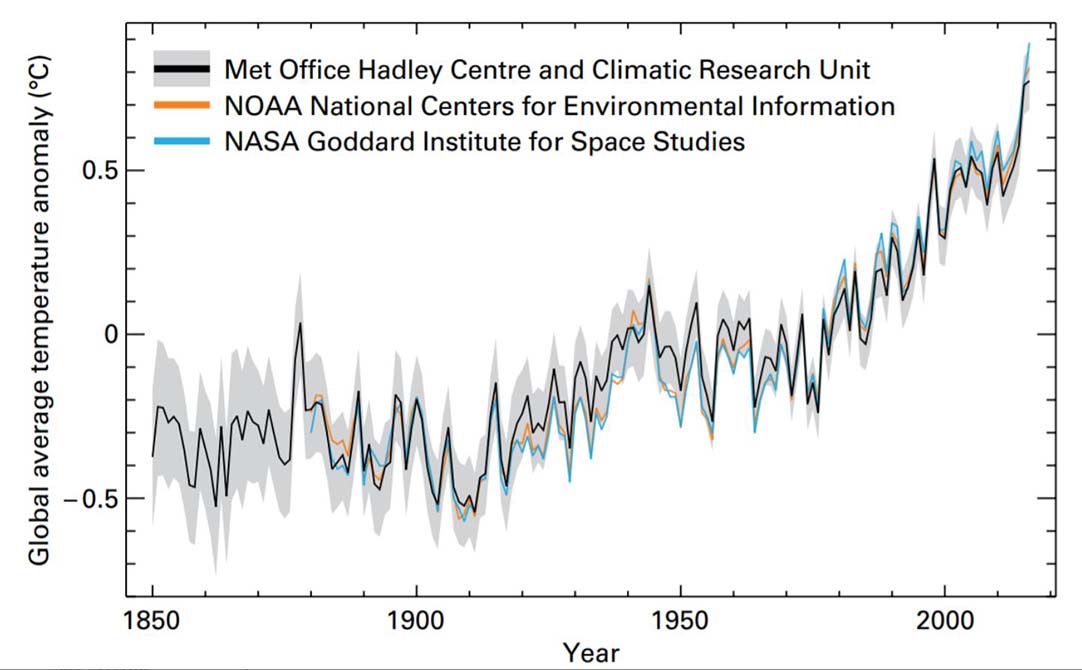
Text version
Global average surface temperature anomalies (deviations from the 1961-1990 average). The grey shading indicates the uncertainty in the dataset, however, the overall trend has clearly increased. Source: Met Office Hadley Centre and the Climatic Research Unit at the University of East Anglia, UK (HadCRU) presented in World Meteorological Organization, 2017. WMO Statement on the State of Global Climate Change in 2016 (WMO-No. 1189), Figure 1, Page 5.
Climate and habitat changes affect every life stage of salmon
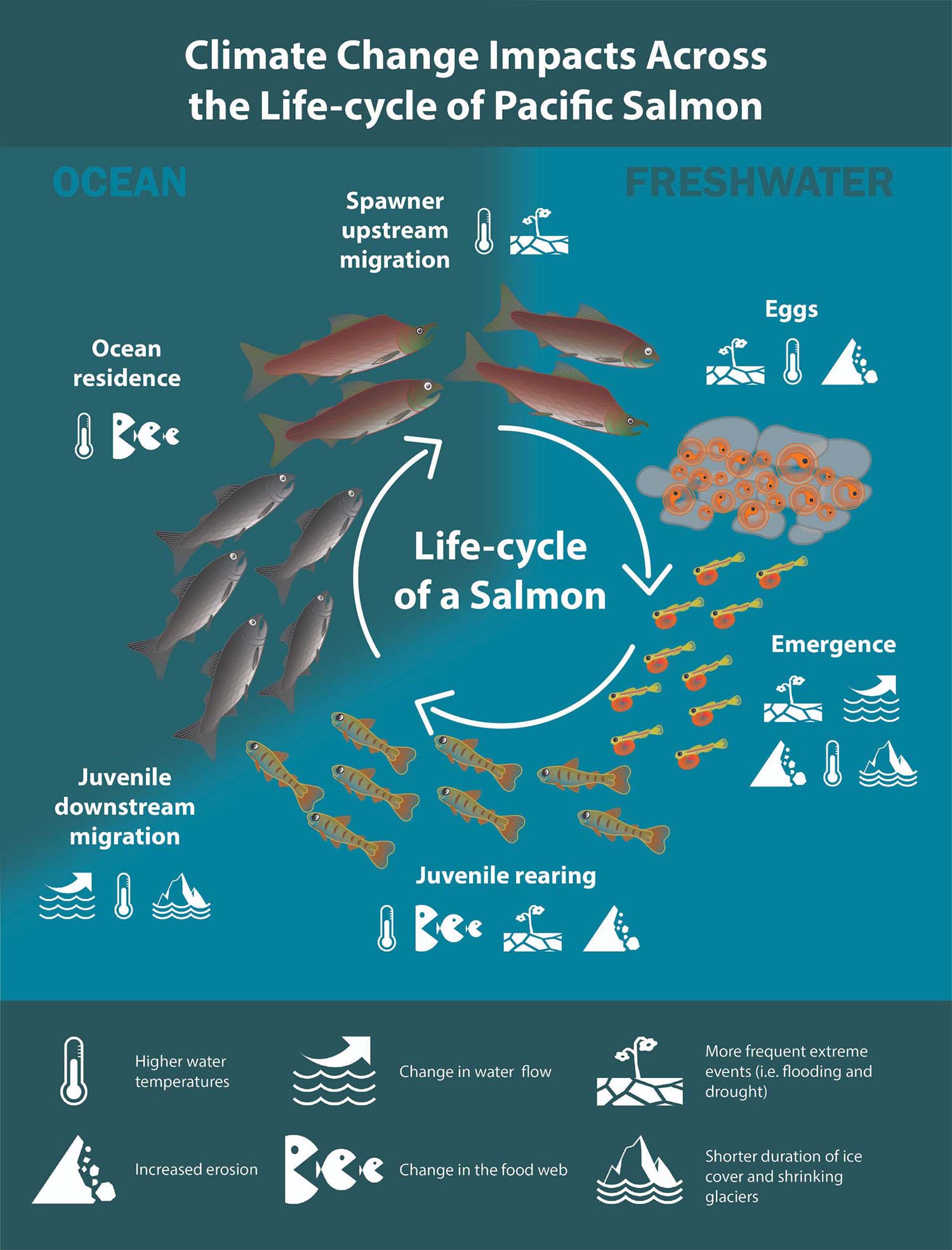
Text version
Climate change impacts across the life-cycle of Pacific salmon.
The Pacific salmon life-cycle alternates between freshwater and the ocean. Stages of development include eggs, emergence, juvenile rearing, juvenile downstream migration, ocean residence and spawner upstream migration. Climate change impacts include:
- higher water temperatures which are present in all stages
- change in water flow which is present in the emergence and juvenile downstream migration stages
- more frequent extreme events (i.e., flooding and drought) which are present in the egg, emergence, juvenile rearing and spawner upstream migration stages
- Increased erosion which is present in the egg, emergence and juvenile rearing stages
- Changes in the food web which are present in the juvenile rearing and ocean residence stages
- Shorter duration of ice cover and shrinking glaciers which are present in the emergence and juvenile downstream migration stages
Effects of global climate change are becoming apparent in salmon habitats. The recent period of extremely warm conditions caused changes in the freshwater and marine ecosystems salmon use throughout their life-cycle. Longer term landscape changes, of both human and natural origin, are interacting with these effects.
Changes in marine and freshwater ecosystems used by Pacific salmon include:
- higher water temperatures
- food web changes
- changes in timing of peak river flows
- more drought and heavy rain events
- increased erosion
- shrinking glaciers and shorter periods of ice cover on rivers and lakes
These changes are affecting Pacific salmon at every stage of their life-cycles, and are altering the numbers and locations of those that survive to spawn.
Climate change in marine salmon habitats
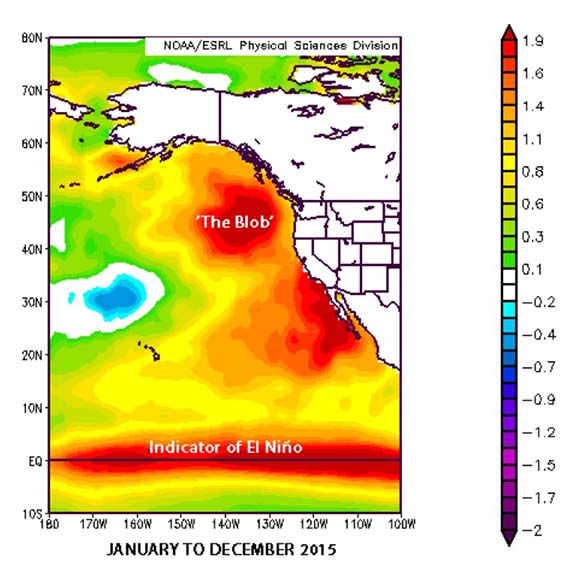
Text version
NOAA sea-surface-temperature anomalies in the Northeast Pacific Ocean in 2015
The map does not show absolute temperatures, but indicates how much above (red) or below (blue) average the ocean surface temperatures were, compared to a thirty year average from 1981 to 2010. Anomalies are optimum interpolation sea-surface-temperatures as described on NOAA webpage.
Northeast Pacific Ocean temperatures have steadily increased since 1950.
An extremely strong marine heatwave, nicknamed 'The Blob', was present from 2013 to 2017 in the Northeast Pacific Ocean, where most Canadian Pacific salmon feed and grow. A strong El Niño event in late 2015 to early 2016 caused further warming in this area, leading to the hottest ocean temperatures observed in 137 years of monitoring.
Extreme marine heatwaves and El Niño events are expected to become more common with climate change.
We produce annual State of the Pacific Ocean reports, which contain detailed information on conditions in the Northeast Pacific Ocean. Changes in conditions across Canada’s oceans can be found in our 2012 State of the Ocean report.
Climate change and marine food webs
Zooplankton size by temperature
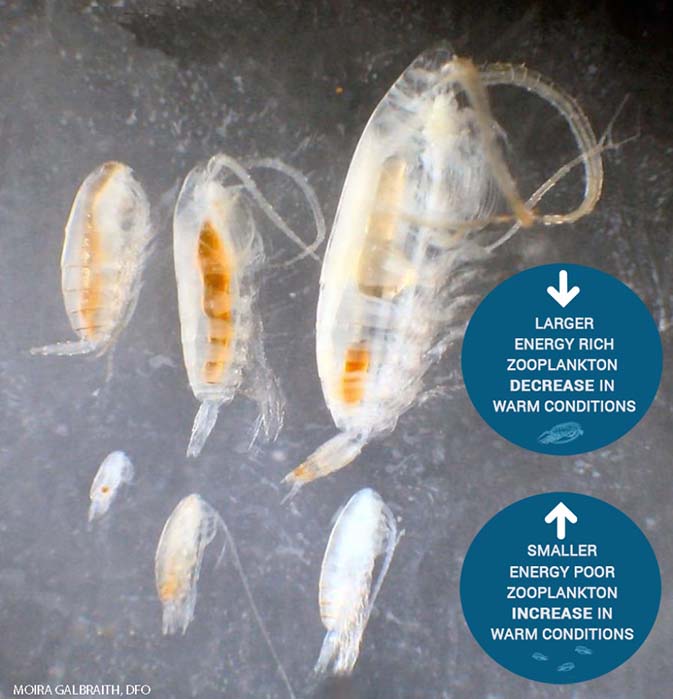
Text version
Larger energy rich zooplankton species from the north dominate the base of Northeast Pacific Ocean food web in cooler years.
Smaller energy poor zooplankton species from the south dominate in warmer years.
Photo Credit: Moira Galbraith, Fisheries and Oceans Canada, La Perouse Zooplankton Program.
Marine heatwaves affect physical and biological processes in the ocean, causing considerable effects on the marine food web salmon rely on.
Less nutritious zooplankton species, typically found south of BC, dominate the Northeast Pacific Ocean during warmer periods. Zooplankton are small animals that form the base of the salmon food web.
Aquatic species from Mexico and other southern locations also appear in local marine waters during periods of unusually warm conditions. For example, during the most recent heatwave large numbers of pyrosomes were observed in BC coastal waters. These animals are not typically detected in this area. Although it is not well understood how these unusual species affect salmon, these observations indicate that marine ecosystems and food webs are changing.
Climate change in freshwater salmon habitats
The warming climate is causing many changes in the rivers and lakes salmon use during their critical freshwater life stages. Some of these changes include warmer water temperatures, changes in patterns of river flow across seasons, more extreme river flows, erosion of soil, rock, and organic matter into water bodies, declining oxygen levels in some lakes, and changes in the timing of rivers and lakes freezing over.
The generally negative effects of these changes:
- reduce salmon habitat availability and quality
- stress salmon, making them less healthy and sometimes causing death
- alter timing of biological processes creating mismatches with food availability
- increase salmon metabolism, which means that salmon require more food to grow
Climate change in freshwater salmon habitats
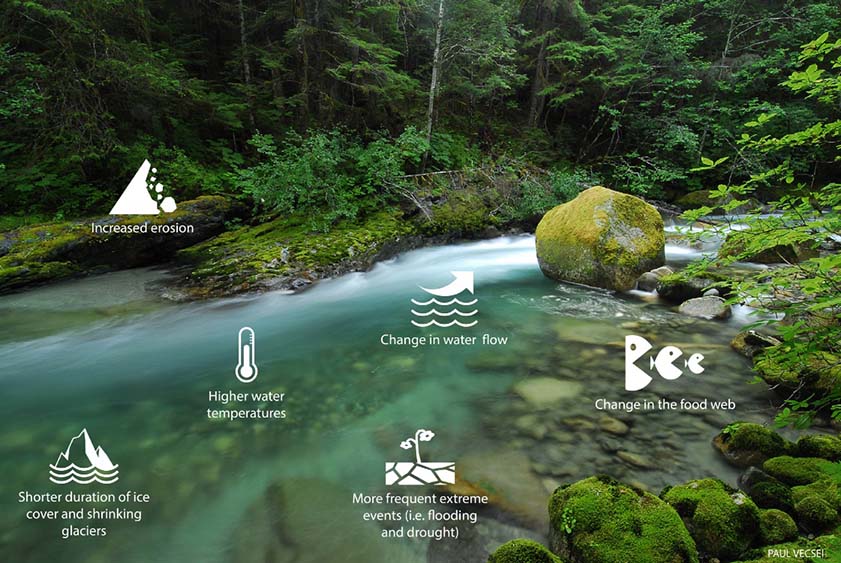
Text version
Climate changes in freshwater salmon habitats include:
- increased erosion
- shorter duration of ice cover and shrinking glaciers
- high water temperatures
- changes in water flow
- more frequent extreme events (i.e. flooding and drought)
- changes in the food web
Impacts of landscape changes on salmon freshwater habitats
Humans are altering BC and Yukon landscapes in ways that negatively affect salmon habitat.
Broad-scale landscape change has been occurring in salmon habitats over the long term. Urban development, agriculture, mining, forestry, and other human activities are contributing to increased pollution, nutrient inputs, water extraction, and deforestation. Such changes can make freshwater ecosystems even more vulnerable to the impacts of climate change, through their effects on water availability and water quality for salmon.
For example, loss of forest canopy around rivers and lakes removes the cooling effect of shade, further increasing water temperatures in response to the rising air temperatures associated with climate change.
Deforestation also makes river valleys more prone to erosion and landslides, both of which will increase as climate change brings more rainfall and heavy rain events to Canada’s West Coast. Increased erosion of soil, rock, and organic matter into rivers and lakes may decrease water quality for salmon, smother incubating eggs, and block salmon from migrating.
Effects of deforestation during extreme rain
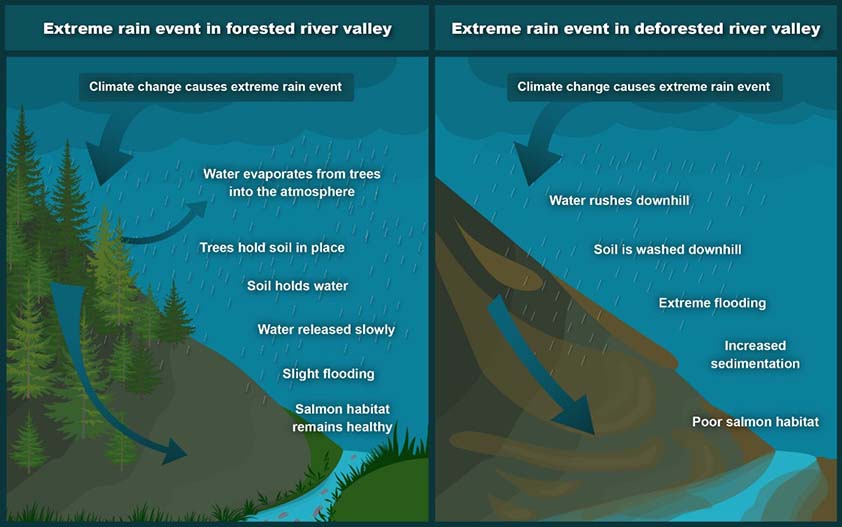
Text version
When climate change causes extreme rain events in a forested river valley:
- water evaporates from trees into the atmosphere
- trees hold soil in place
- soil holds the water
- water is released slowly
- slight flooding may occur
- salmon habitat remains healthy
When climate change causes extreme rain events in a deforested river valley:
- water rushes downhill
- soil is washed downhill
- extreme flooding may occur
- sediment increases
- salmon habitat becomes poor
Other factors that affect salmon
Fisheries, hatcheries, disease, pollutants, invasive species, and other natural and human-caused factors can also affect salmon.
Climate change interacts with all these factors, and others, to influence salmon numbers.
Research is underway to assess the effects of hatcheries, disease, contaminants and invasive species, both through our own programs and through external initiatives, including university research programs.
We are working to improve our understanding of how these factors interact with salmon, alone or cumulatively, and how they interact with climate change.
Recent trends in salmon numbers
Fisheries, hatcheries, disease, pollutants, invasive species, and other natural and human-caused factors can also affect salmon.
Climate change interacts with all these factors, and others, to influence salmon numbers.
Research is underway to assess the effects of hatcheries, disease, contaminants and invasive species, both through our own programs and through external initiatives, including university research programs.
We are working to improve our understanding of how these factors interact with salmon, alone or cumulatively, and how they interact with climate change.
Recent trends in salmon numbers
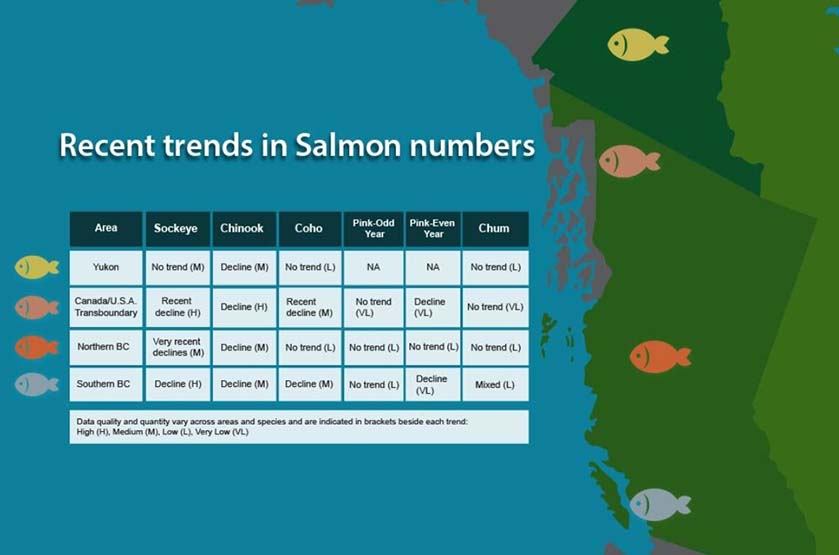
Text version
Data quality and quantity vary across areas and species and are indicated in brackets beside each trend:
- High (H)
- Medium (M)
- Low (L)
- Very low (VL)
| Area | Sockeye | Chinook | Coho | Pink (odd year) | Pink (even year) | Chum |
|---|---|---|---|---|---|---|
| Yukon | No trend (M) | Decline (M) | No trend (L) | NA | NA | No trend (L) |
| Canada/U.S.A. transboundary | Recent decline (H) | Decline (H) | Recent decline (M) | No trend (VL) | Decline (VL) | No trend (VL) |
| Northern B.C. | Very recent decline (M) | Decline (M) | No trend (L) | No trend (L) | No trend (L) | No trend (L) |
| Southern B.C. | Decline (H) | Decline (M) | Decline (M) | No trend (L) | Decline (VL) | Mixed (L) |
Traits of healthy salmon populations
Despite the combined impacts of climate and habitat changes, not all salmon populations have declined in numbers in recent years. Insight into how salmon will respond to future climate change may be gained by comparing the performance of salmon populations during the recent period of extremely warm conditions and associated changes.
Canadian Pacific salmon populations that have generally not shown declines in recent years share some common traits. These include populations that:
- spawn further north
- spend less time in freshwater
- use largely undisturbed freshwater habitats
- are more flexible to spawn in a range of locations and habitats
Other factors will also contribute to the climate change responses of Pacific salmon populations. Our understanding of what determines these responses is still incomplete.
Sustaining future salmon populations in the face of climate change requires collaboration
To predict future trends in Pacific salmon populations in response to climate and habitat change, we must understand what makes them vulnerable to these changes.
Our 2019 State of Canadian Pacific Salmon: Responses to Changing Climate and Habitats report provides a starting point for this work.
Another workshop we have conducted provides some methods for salmon vulnerability assessments to climate change. Read the Climate change vulnerability assessment methods workshop proceedings
NOAA Fisheries has initiated salmon vulnerability assessments in the U.S., and this work can assist with related work on our Canadian Pacific salmon populations.
International collaboration has also begun through the International Year of the Salmon to improve our understanding of salmon and ecosystem trends on a global scale.
We have initiated a Pacific Salmon-Ecosystem Climate Consortium to foster integration of our collective science on salmon, their ecosystems, and climate. This collaborative work will integrate the relevant science, in order to improve predictions of salmon responses to climate change. Groups that will be invited to engage include salmon and ecosystem experts from government, academia, Indigenous Communities, and environmental organizations.
We are the principle authority for managing Canada’s Pacific salmon. However, we share authority with others when it comes to maintaining healthy ecosystems to sustain wild salmon in freshwater and marine areas. Environment and Climate Change Canada, the BC Provincial and Yukon Governments, First Nations, and others, need to be formally engaged in these collaborative processes. This engagement is critical to advancing work on salmon vulnerability to climate change.
Science on Pacific salmon and their ecosystems
We conduct monitoring and research to track and understand why salmon numbers vary across populations and over time. We rely on many other groups who contribute to this work, including First Nations, academia, non-profit organizations, and the BC Provincial and Yukon Governments.
Studying salmon and their ecosystems supports management of salmon populations and their habitats. Much of this work is focused on the adult life stage in marine waters, and as they return to their spawning grounds. Work on younger life-stages is also conducted in a few freshwater systems, within the Strait of Georgia and coastal waters, and in the Northeast Pacific.
Integrating and developing new research on salmon is required to better understand how they will respond to climate and habitat changes. This includes collaborative research across salmon topics, including physiology, population dynamics, evolution, species interactions, and predictions of climate-related habitat changes.
Current and future states of our Pacific salmon
Our State of Canadian Pacific Salmon report describes how salmon and their ecosystems have responded to a recent period of warm conditions combined with long term habitat change. This provides clues on how salmon may respond to future climate and habitat changes.
We have learned that some salmon populations have responded poorly to these changes, while others have not.
By comparing the trends across populations and species, we have gained some insight into traits of salmon populations that may be more resilient to future climate change.
Effective monitoring of salmon and their ecosystems, related research, and integration of all this work, can help refine our predictions.
This information is critical, and will help ensure our fisheries management, salmon recovery, and habitat restoration actions are aligned to future salmon production and diversity that will occur with climate change.
Related links
- State of the Canadian Pacific Salmon: Responses to Changing Climate and Habitats (full report)
- Video: Ocean Monitoring of the Canadian West Coast
Pacific salmon
Climate change
- Canada's Changing Climate Report, 2019
- IPCC (2018) Global Warming of 1.5°C
- IPCC (2014) Impacts, Adaptation and Vulnerability
Climate change in marine environments:
- State of the Pacific Ocean
- The Warmest Year, the Blob, La Niña, and a Series of Unusual Events, 2016
- NOAA El Niño webpage
- Date modified: